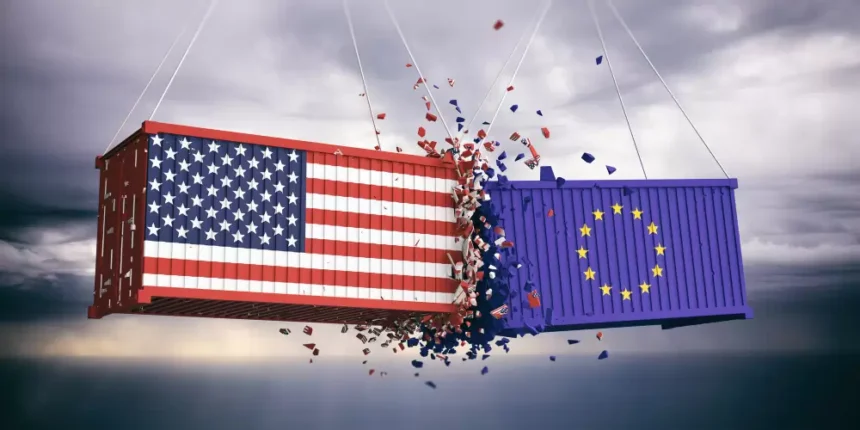Tensions have escalated dramatically across the Atlantic as the U.S and the EU clashed over a heated trade conflict.
It was gathered that the U.S. and the EU clashed with both powers are now threatening to impose heavy tariffs on a wide array of goods, igniting fears of an economic slowdown that could have widespread repercussions.
As negotiations falter and diplomatic relations further deteriorate, the potential for a full-blown trade war casts a shadow over the global economy, raising concerns among industry leaders and consumers alike about rising prices and disrupted supply chains.
On Tuesday, February 11, 2025, European Union (EU) leaders, led by European Commission President Ursula von der Leyen, vowed a “firm” and “proportionate” response to US President Donald Trump’s decision to impose tariffs on steel and aluminium imports from the EU, effective from March 12, 2025.
This has reignited fears of a broader trade war, reminiscent of Trump’s first term when similar tariffs were imposed in 2018.
This comes as Trump’s tariff policies have been a cornerstone of his economic agenda, both during his first term (2017–2021) and in his second term, which began in January 2025.
The US President has long argued that tariffs are necessary to protect American industries, reduce trade deficits, and boost domestic manufacturing.
His latest executive orders, signed on Monday, February 10, 2025, impose 25% tariffs on steel and aluminium imports from several countries, including EU member states, as well as Argentina, Australia, Canada, Mexico, and the UK.
Separate orders extended steel tariffs to Brazil, Japan, and South Korea, with Trump hinting at further duties on cars, pharmaceuticals, and computer chips.
This move echoes Trump’s 2018 tariffs on steel (25%) and aluminium (10%) imports, which targeted the EU, Canada, and Mexico, among others.
At the time, the EU retaliated with tariffs on US goods worth €2.8 billion, including iconic American products like Harley-Davidson motorcycles, Levi’s jeans, and bourbon whiskey.
The 2018 tariffs were eventually suspended under the administration of the immediate past US President Joe Biden in 2021, following a truce that sought to de-escalate tensions.
However, Trump’s return to office in 2025 has revived these trade disputes, with the EU now bracing for another round of retaliatory measures
The EU, in its reaction, said the union is determined to protect its economic interests, workers, businesses, and consumers.
The EU President issued a strong statement condemning the US tariffs, calling them “unjustified” and warning that they “will not go unanswered.”
She emphasized that the EU would respond with “firm and proportionate countermeasures” to safeguard its economic interests.
Similarly, German Chancellor Olaf Scholz, leader of the EU’s largest economy, echoed von der Leyen’s sentiments, emphasizing the bloc’s unity.
He stated that the EU would “act together as the largest market in the world” to counter the US tariffs. Scholz has previously stressed the importance of open trade and warned against dividing the global economy with tariff barriers.
Also, EU Trade Commissioner Maros Sefcovic described the tariffs as a “lose-lose scenario,” warning that they were “economically counterproductive.”
Speaking to the EU Parliament in Strasbourg, France, on February 11, 2025, Sefcovic argued that the US tariffs would effectively tax American citizens by raising costs for businesses and fueling inflation.
He highlighted the interconnected nature of EU-US trade, noting that the two regions have the world’s largest commercial relationship, with €1.5 trillion ($1.55 trillion) in goods and services traded in 2023.





